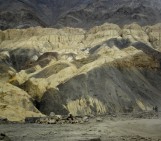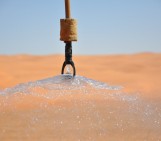Most lakes in the Northern hemisphere are formed through the erosive power of glaciers during the last Ice Age; but not all. Lake Baikal is pretty unique. For starters, it is the deepest fresh water lake in the world. This means it is the largest by volume too, holding a whopping 23,615.39 cubic kilometres of water. Its surface area isn’t quite so impressive, as it ranks as the 7th largest in the world. However, it makes up for that by also being the world’s oldest lake, with its formation dating back 25 million years – a time during which mammals such as horses, deer, elephants, cats and dogs began to dominate life on Earth.
Located in a remote area in Siberia, perhaps, most impressive of all is how Lake Baikal came to be. It is one of the few lakes formed through rifting. The lake is in fact, one of only two continental rifted valleys on our planet. Typically, “continental rift zones are long, narrow tectonic depressions in the Earth’s surface”, writes Hans Thybo, lead author of a paper on the subject. The Baikal rift zone developed in the last 35 million years, as the Amurian and Eurasian Plate pull away from one another. Eventually, the stretching of the Earth’s surface, at continental rifted margins, can lead to continental lithosphere splitting and the formation of new oceanic lithosphere. Alternatively, as is the case in Siberia, extensive sedimentary basins can be formed; bound by faults, they are known as grabens. It is by this process that Lake Baikal was formed and now houses around 20% of the world’s fresh water!
But this is not where the amazing facts about today’s Imaggeo on Monday’s picture end. The lake is the origin of the Angara River, along which you’ll find the manmade Bratsk Dam, the world’s second largest dam! The shoreline pictured in this photo by Jean- Daniel Paris, is from this impressive dam. Completed in 1964, this artificial reservoir is home to almost 170 billion cubic meters of water (equivalent to the volume held by 68 million Olympic sized swimming pools!).
However, it’s not the impressive water bodies in this inaccessible location in Siberia that are of interest to Jean-Daniel. In fact, this photograph was taken from a research aircraft, which flew over the region for an investigation that spanned a period of several years. Its aim was to measure how concentrations of CO2 and CO varied across the region. Acquiring this data would allow the team of scientist to better understand the sources of the gases, in this remote area of Russian, due to anthropogenic activities and biomass burning.
Reference
Thybo, H., Nielsen, C.A.: Magma-compensated crustal thinning in continental rift zones, Nature, 457, 873-876, doi: 10.1038/nature07688, 2009
Imaggeo is the EGU’s online open access geosciences image repository. All geoscientists (and others) can submit their photographs and videos to this repository and, since it is open access, these images can be used for free by scientists for their presentations or publications, by educators and the general public, and some images can even be used freely for commercial purposes. Photographers also retain full rights of use, as Imaggeo images are licensed and distributed by the EGU under a Creative Commons licence. Submit your photos at http://imaggeo.egu.eu/upload/.



